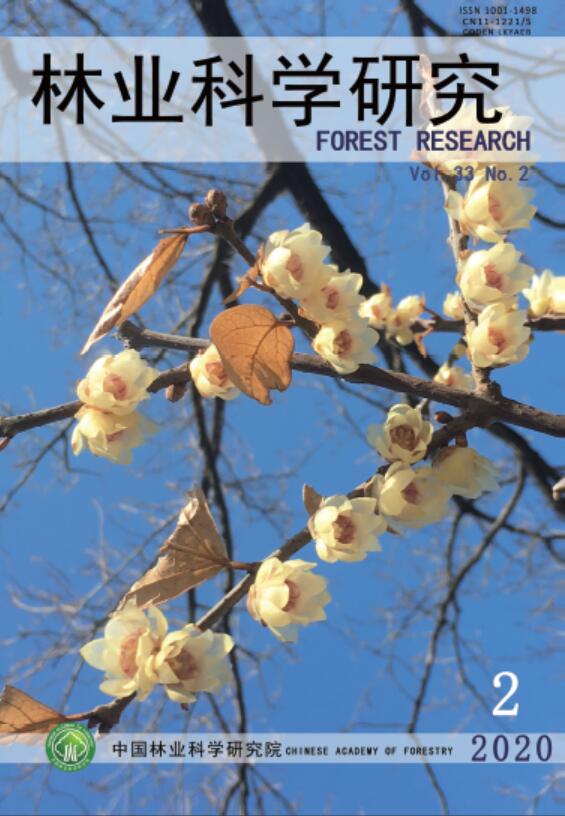-
天牛科(Cerambycidae),隶属鞘翅目,目前全世界确定有35 000种,中国纪录有约2 700种,估计将超过3 000种[1-2]。天牛科昆虫作为一类重要的林业钻蛀性害虫,以幼虫蛀干危害为主,蛀食树木边材或心材,造成树势衰弱,严重时导致树木死亡;成虫蛀食嫩枝和树干,传播病原物,对林木造成很大危害,严重损害了森林生态系统的经济和生态效益[3-10]。天牛科幼虫通常寿命很长,可隐藏于木制品和运输材料中,通过全球贸易输入或输出,在全球范围内传播,因此,天牛科昆虫在林业上是最常见的检疫对象[11-14]。其中有些种类如松褐天牛(Monochamus alternatus)、光肩星天牛(Anoplophora glabripennis)等都是重要的检疫性害虫,尤其是松褐天牛,除直接为害松树外,还传播松材线虫(Bursaphelenchus xylophilus),引起松林大片枯死,给我国林业生产和生态环境带来巨大的危害[15]。
近年来,鳞翅目昆虫化学生态学研究领域不断取得重大进展,但是关于鞘翅目昆虫的化学生态学研究较为缓慢,2004年之前,仅仅鉴定了10种左右的天牛信息素组分[5]。但是之后的十几年,随着昆虫化学生态学逐渐被重视,许多科学家开始参与到天牛信息素的研究,目前,已经从超过100种天牛物种中鉴定出信息素或可能的信息素,各个种间信息素的比例和组分都不尽相同[16]。目前,天牛信息素的研究主要集中在性信息素、接触信息素、聚集信息素等方面[17]。
信息化合物对害虫综合防治及农林生产具有重要影响[18-19]。天牛科昆虫信息素介导的通信可能代表了最古老的通信模式,天牛通过味觉和嗅觉感知信息素释放的信号以获得有关其生物和非生物环境的信息,因此,信息素在天牛科的生活史中至关重要[5]。天牛信息素中的某些组分可以调控其行为活动,如天牛成虫可被某些信息化合物吸引,所以人们常利用这些化合物作为诱饵来诱捕天牛。本文综述了天牛科昆虫信息化合物的研究概况以及信息化合物对天牛科昆虫的应用防控,力求为进一步深入研究提供参考。
HTML
-
目前全球鉴定的天牛科昆虫信息素组分主要包含10亚科200属406种。其中,以沟胫天牛亚科(Lamiinae)、天牛亚科(Cerambycinae)、锯天牛亚科(Prioninae)研究最为广泛(表1)。
亚科
Subfamily属/个
Genus种/个
Species信息素组分/种
Pheromone component代表种
Representative species参考文献
Reference沟胫天牛亚科Lamiinae 64 122 101 Anoplophora chinensi星天牛
Monochamus alternatus松褐天牛[20]
[21]天牛亚科Cerambycinae 82 165 168 Hylotrupes bajulus北美家天牛
Xylotrechus quadripes咖啡灭字脊虎天牛[23] 花天牛亚科Lepturinae 34 69 85 Ortholeptura valida [24] 椎天牛亚科Spondylidinae 4 20 47 Tetropium fuscum暗褐断眼天牛
Tetropium castaneum光胸断眼天牛[25]
[26]锯天牛亚科Prioninae 9 22 23 Megopis costipennis脊薄翅天牛 [27] 瘦天牛亚科Disteniinae 1 1 3 Distenia undata [28] Anoplodermatinae 1 1 2 Migdolus fryanus [29] Parandrinae 1 1 1 褐异天牛Neandra brunnea [30] Necydalinae 1 2 10 Necydalis pennata [31] 未知 1 1 2 Stenocentrus ostricilla [32] 未知 1 1 1 Syllitus grammicus [32] Vesperinae 1 1 1 Vesperus xatarti [33] 总计 200 406 444 注:信息素组分总计数包括各个亚科之间的相同组分重叠数;属和种是该亚科内已鉴定出信息素组分或是能被某些组分合成的信息化合物吸引的属和种数目。
Note: The total count of pheromone components includes the number of overlaps of the same components among subfamilies; genera and species are the number of genera and species that have been identified as pheromone components in this subfamily or can be attracted by the compounds synthesized by certain components.Table 1. Identification of pheromones of Cerambycidae insects
-
天牛科昆虫的信息素类型有挥发性信息素和非挥发性信息素。挥发性信息素有两种类型:聚集信息素[20],由雄虫产生并吸引两性,其作用距离较长;性信息素,由雌虫产生的仅吸引雄虫[16],其作用距离较短。已有的研究表明,天牛亚科(Cerambycinae),沟胫天牛亚科(Lamiinae)和椎天牛亚科(Spondylidinae)3个亚科的物种产生聚集信息素组分,锯天牛亚科和花天牛亚科两个亚科的物种产生性信息素组分。一般来说,不同类型信息素化学组分会明显不同,但不同属或不同亚科物种的同种类型信息素存在相同或相似的信息素组分。非挥发性信息素主要是雌虫体壁的接触性信息素成分,其主要是由高分子甲基支链烷烃或者烯烃构成,作为雌雄天牛生殖交配识别的化学信号[34]。还有一类天牛雌雄成虫均不分泌挥发性信息素,寄主挥发性成分对其种群聚集具有重要作用,成虫可通过寄主挥发信息素来定位宿主植物并以宿主为食,有些挥发信息素能被天牛成虫表皮角质层吸引,角质层吸收挥发信息素的天牛也可继续吸引配偶,因此,寄主挥发性信息素直接或间接介导天牛雌雄成虫的交配行为[35-37]。
-
迄今为止,天牛科天牛亚科(Cerambycinae),沟胫天牛亚科(Lamiinae)和椎天牛亚科(Spondylidinae)3个亚科中的所有物种,其挥发性信息素都是由雄虫产生的聚集信息素。目前已鉴定天牛科雄性聚集信息素组分包括酮类16种、醇类19种、酯类4种、醛类5种、酸类1种、烯烃2种(表2)。
化合物名称
Chemical Name化学结构
Structure物种
Species参考文献
Reference(R)-3-羟基-2-己酮
(R)-3-hydroxy-2-hexanone
Anaglyptus subfasciatus柳杉纹虎天牛
Plagionotus detritus ssp截尾丽虎天牛等[62]
[42](S)-3-羟基-2-己酮
(S)-3-hydroxy-2-hexanone
Xylotrechus colonus宽斑脊虎天牛
Xylotrechus nauticus
Callidiellum rufipenne[30]
[43]
[44](R)-2-羟基-3-己酮
(R)-2-hydroxy-3-hexanone
Callidiellum rufipenne
Anelaphus inflaticollis
Callidiellum rufipenne
Xylotrechus pyrrhoderus青杨虎天牛[44]
[63]
[44]
[38]2-羟基-3-己酮
2-hydroxy-3-hexanone
Hylotrupes bajulus北美家天牛 [22] 3-羟基-2-辛酮
3-hydroxy-2-octanone
Xylotrechus chinensis桑脊虎天牛 [64] (R)-3-羟基-2-辛酮
(R)-3-hydroxy-2-octanone
Anaglyptus subfasciatus柳杉纹虎天牛 [62] 2-羟基-3-辛酮
2-Hydroxy-3-octanone
Xylotrechus quadripes灭字脊虎天牛
Xylotrechus chinensis桑脊虎天牛[23]
[64]S-2-羟基-3-辛酮
S-hydroxy-3-octanone
Xylotrechus chinensis桑脊虎天牛
Plagionotus detritus ssp截尾丽虎天牛[39]
[42]2-羟基-3-癸酮
2-hydroxy-3-decanone
Xylotrechus quadripes灭字脊虎天牛 [46] (S)-2-羟基-3-癸酮
(S)-2-hydroxy-3-decanone
Xylotrechus quadripes灭字脊虎天牛 [23] 3-羟基-2-癸酮
3-hydroxy-2-decanone
Xylotrechus quadripes灭字脊虎天牛 [23] 2,3-己烷二酮
2,3-hexanedione
Anelaphus inflaticollis
Hylotrupes bajulus北美家天牛[63]
[22]2,3-辛烷二酮
2,3-octanedione
Tylonotus bimaculatus双沟天牛
Xylotrechus chinensis葡萄虎天牛[44]
[64]2,3-癸烷二酮
2,3-decanedione
Xylotrechus quadripes灭字脊虎天牛 [23] 香叶基丙酮
geranyl acetone
Astylidius parvus
Hedypathes betulinus
Lepturges angulatus[26]
[55]
[26]1-(1H-pyrrol-2-yl)-1,2-propanedione
1-(1H-吡咯-2-基)-1,2-丙二酮
Dryobius sexnotatus [41] (2S, 3S)-2,3-辛二醇
(2S,3S)-2,3-octaediol
Xylotrechus pyrrhoderus青杨虎天牛
Xylotrechus quadripes灭字脊虎天牛[38]
[23](2R, 3S)-2,3-己二醇
(2R, 3S)-2,3-hexanediols
Anelaphus inflaticollis
Hylotrupes bajulus北美家天牛
Megacyllene caryae厚垫黄带蜂天牛[63]
[22]
[50](2R, 3R)-2,3-己二醇
(2R, 3R)-2,3-hexanediols
Anelaphus inflaticollis
Hylotrupes bajulus北美家天牛
acuminatus黑腹尼虎天牛
Xylotrechus colonus宽斑脊虎天牛
Pyrrhidium sanguineum栎红天牛[63]
[22]
[49]
[30]
[48](2S, 3R)-2,3-己二醇
(2S, 3R)-2,3-hexanediols
Megacyllene caryae厚垫黄带蜂天牛
Sarosesthes fulminans
Pyrrhidium sanguineum栎红天牛[50]
[30]
[48](2S, 3S)-2,3-己二醇
(2S, 3S)-2,3-hexanediols
Neoclytus acuminatusacuminatus黑腹尼虎天牛
Xylotrechus colonus宽斑脊虎天牛[49]
[30]1-丁醇
1-Butanol
Hylotrupes bajulus北美家天牛 [22] R-2-甲基-丁醇
(R)-2-methylbutan-1-ol
Phymatodes lecontei [43] 橙花醇
Nerol
Megacyllene caryae厚垫黄带蜂天牛 [50] 2-(十一烷氧基)-乙醇
2-(undecyloxy)-ethanol
Monochamus alternatus松褐天牛
Monochamus carolinensis卡罗林墨天牛
Monochamus galloprovincialis樟子松墨天牛
Monochamus saltuarius云杉花墨天牛
Monochamus scutellatus白点墨天牛
Monochamus sutor云杉小墨天牛
Monochamus titillator北美墨天牛[21]
[65]
[59]
[60]
[66]
[59]
[65]2-(庚氧基丁氧基)乙醇
2-(heptyloxybutoxy)ethanol
Monochamus leuconotus [23] 4-(庚氧基)-丁醇
4-(n-heptyloxy)butan-1-ol
Anoplophora glabripennis光肩星天牛
Anoplophora chinensis星天牛[58]
[20]2-Phenylethanol
2-苯基乙醇
Megacyllene caryae厚垫黄带蜂天牛
Xylotrechus quadripe灭字脊虎天牛[50]
[23]Alpha terpineol
α-松油醇Megacyllene caryae厚垫黄带蜂天牛 [50] (Z)-3-癸烯醇
(Z)-3-decenol
Rosalia funebris桤木丽天牛 [51] S-fuscumol 
Astyleiopus variegatus
Astylidius parvus细小星天牛
Tetropium castaneum光胸断眼天牛
Tetropium fuscum暗褐断眼天牛
Hedypathes betulinus[67]
[67]
[26]
[60]
[56]R-fuscumol 
Astylidius parvus
Hedypathes betulinus[26]
[56](E)-6,10-二甲基十一烷-5,9-二烯醇Fuscumol 
Hedypathes betulinus
Tetropium fuscum暗褐断眼天牛
Tetropium cinnamopterum棕翅断眼天牛[50]
[25]
[25]S-fuscumol acetate 
Astyleiopus variegatus
Lepturges angulatus
Hedypathes betulinus[67]
[67]
[26]R-fuscumol acetate 
Lepturges angulatus
Astylidius parvus
Hedypathes betulinus[26]
[26]
[26](E)-6,10-二甲基-5,9-十一二烯-2-乙酸乙酯(E)-6,10-dimethyl-5,9-undecadien-2-yl acetate(fuscumol acetate) 
Hedypathes betulinus [56] (Z)-3-癸烯基(E)-2-己烯酸甲酯
(Z)-3-decenyl(E)-2-hexenoate
Rosalia funebris桤木丽天牛 [51] (Z)-3-壬烯基(E)-2-己烯酸酯
(Z)-3-nonenyl(E)-2-hexenoate
Rosalia funebris桤木丽天牛 [51] (Z)-3-癸烯基(E)-3-己烯酸酯
(Z)-3-decenyl(E)-3-hexenoate
Rosalia funebris桤木丽天牛 [51] 香叶醛
Geranial
Megacyllene caryae厚垫黄带蜂天牛 [50] 4-(正庚氧基)丁醛
4-(n-heptyloxy)butanal
Anoplophora chinensis星天牛
Anoplophora glabripennis光肩星天牛[20]
[57]10-Methyldodecanal
10-甲基十二烷醛
Eburodacrys vittata [53] (6E, 8Z)-6,8-戊二烯醛
(6E,8Z)-6,8-Pentadecadienal
Chlorida costata
Chlorida festiva刺膝天牛[52]
[52](2E, 6Z, 9Z)-2,6,9-Pentadecatrienal
(2E, 6Z, 9Z)–2, 6, 9-戊三烯醛
Elaphidion mucronatum长刺刺腿天牛 [54] 辛酸
octanoic acid
Xylotrechus quadripes灭字脊虎天牛 [23] (3E, 6E )-α-法尼烯
(3E, 6E)-α-farnesene
Anoplophora glabripennis光肩星天牛 [58] S-Limonene
S-柠檬烯
Megacyllene caryae厚垫黄带蜂天牛 [50] Table 2. Pheromones components and sources produced by males of Cerambycidae
-
目前已经从天牛亚科的21个属33个物种中鉴定出聚集信息素组分(表2)。聚集信息素是从天牛科鉴定出来的第一种信息素,羟基酮和2,3-烷基二醇型化合物是首先被鉴定出来的聚集信息素组分类型。Iwabuchi等人鉴定并证明葡萄虎天牛(Xylotrechus pyrrhoderus)雄虫产生(S)-2-羟基-3-辛酮和(2S, 3S)-2,3-辛二醇[38];随后的研究结果显示,同属的桑脊虎天牛(X.chinensis)和灭字脊虎天牛(X. quadripes)也能产生这两种化合物[23, 39]。至今,从其它的天牛亚科雄虫中发现的羟基酮和2,3-烷基二醇型化合物包括:从21种天牛亚科物种中发现了(R)-3-羟基-2-己酮(表2),如Mitchel等人从Cyrtophorus verrucosus和Orwellion gibbulum arizonense中鉴定出(R)-3-羟基-2-己酮[40],同样,Diesel等人从Dryobius sexnotatus中也鉴定出该组分[41],最新的研究结果来自Molander等人从截尾丽虎天牛(Plagionotus detritus ssp.)鉴定出该聚集信息素组分[40-42];从宽斑脊虎天牛(Xylotrechus colonus)、Xylotrechus nauticus和红翅杉天牛(Callidiellum rufipenne)中发现了(S)-3-羟基-2-己酮[30, 43-44];从柳杉纹虎天牛(Anaglyptus subfasciatus)鉴定出(R)-3-羟基-2-辛酮[45];从咖啡灭字脊虎天牛(Xylotrechus quadripeschevrolat)鉴定出的(S)-2-羟基-3-癸酮和3-羟基-2-癸酮[46-47];从北美家天牛(Hylotrupes bajulus)鉴定出(2R, 3S)-2,3-己二醇和(2R, 3R)-2,3-己二醇;从Pyrrhidium sanguinium鉴定出(2S, 3R)-2,3-己二醇;以及从黑腹尼虎天牛(Neoclytus acuminatus)鉴定出(2S, 3S)-2,3-己二醇[22, 48-49]。羟基酮和2,3-烷基二醇型化合物在天牛亚科中是高度保守的,来自不同的属、群落以及不同大陆的物种,都使用这些密切相关的结构,这两种类型化合物已被鉴定为世界上不同地区许多天牛品种的信息素组分或可能的信息素组分(表2)。如2,3-烷烃二酮已从天牛亚科的5个物种中发现,但是经常在来自雄性天牛的顶空挥发物中发现,迄今为止,没有证据表明它们是引诱剂或增效剂。此外,Zou等人从双沟天牛(Tylonotus bimaculatus)发现的(2S,4E)-2-hydroxyoct-4-en-3-one和(3R,4E)-3-hydroxyoct-4-en-2-one,是羟基酮类化合物的第一个变体,即不饱和类似物[44]。
除了羟基酮和2,3-烷基二醇型信息素之外,有证据表明,天牛亚科还存在许多其它结构的聚集信息素(表2)。例如,已经从几种不同的物种中鉴定出非常小且结构简单的化合物如1-丁醇和2-甲基丁醇的对映体。其它物种,例如从北美本土的双沟天牛(Tylonotus bimaculatus)中发现的(E)-4-辛烯-2,3-二酮,厚垫黄带蜂天牛(Megacyllene caryae)具有由萜类化合物如香叶醛和橙花醛组成的信息素[44, 50]。而桤木丽天牛(Rosalia funebris)产生酯类化合物如(Z)-3-壬烯基,(E)-2-己烯酸酯,(Z)-3-癸烯基(E)-3-己烯酸酯和(Z)-3-癸烯基(E)-2-己烯酸酯,这些酯类物质与许多蝽类昆虫产生的信息化合物相似[51]。Zou等人在日本进行针对红翅杉天牛的田间试验时发现,其雌成虫和雄成虫能被外消旋的3-羟基己-2-酮和一种新型天然产物1-(1H-吡咯-2-基)-1,2-丙二酮的混合物所吸引[44],后Diesel等人从来自北美、南美以及亚洲Dryobius sexnotatus雄虫的顶空挥发物中中鉴定出此种新的吡咯结构[41, 44];此外,最近发现的信息化合物包括不饱和直链醛(6E, 8Z)–6,8-戊二烯醛、10-甲基十二烷醛和(2E, 6Z, 9Z)–2, 6, 9-戊三烯醛[52-54]。
-
目前已经从6个属13种沟胫天牛亚科中鉴定出聚集信息素组分(表2),其中已知或可疑的物种信息素组分有两种主要结构类别。第一类由香叶基丙酮(Geranyl acetone)、(E)-6,10-二甲基十一烷-5,9-二烯-2-醇(fuscumol)及其乙酸酯fuscumol acetate三种化合物组成(表2)。fuscumol和fuscumol acetate两种组分各有两种对映体形式,从巴西Hedypathes betulinus雄虫中鉴定出这两种组分以及它们的4种对映体形式,单个化合物本身不具有吸引力,但是香叶基丙酮、fuscumol acetate和fuscumol 3种组分的混合物可吸引天牛雌成虫[55-56]。最近的一项研究表明,在北美沟胫天牛亚科天牛发现了相对罕见的对映体协同作用现象,细小星天牛(Astylidius parvus)雄虫产生(R)-and (S)-fuscumol+(R)-fuscumol acetate+香叶丙酮,而Lepturges angulatus雄性产生(R)-and (S)-fuscumol acetate +香叶丙酮,这些对映体混合物可吸引相应的天牛雌虫[26]。这些研究结果表明对映体协同作用在沟胫天牛亚科内可能是常见的。
从沟胫天牛亚科物种中发现的第二类信息素结构由羟基醚和相关化合物组成。从光肩星天牛(Anoplophora glabripennis)中鉴定出4-(庚氧基)-丁醇和4-(正庚氧基)丁醛的混合物[57-58]。而后又从亚洲同属雄性星天牛(Anoplophora chinensis)的顶空挥发物中鉴定出这两种成分,但仅有4-(庚氧基)-丁醇能够引起星天牛触角反应,并且该化合物在田间试验中可吸引两性的星天牛成虫[20]。一种相关的信息素组分2-(十一烷氧基)-乙醇(monochamol)最初从欧洲的樟子松墨天牛(Monochamus galloprovincialis)鉴定出来[59],现已经被证明是一些原产于欧亚大陆和北美的12种同属物种的信息素组分或可能的信息素组分,其中已经从同属的6种天牛中鉴定出来(表3)。最新的发现是2-(十一烷氧基)-乙醇已从来自亚洲的云杉花墨天牛(Monochamus saltuarius)鉴定出来,并且该化合物与(−)-α-pinene等增效剂混合使用比单独使用更具吸引力[48]。此外,2-(十一烷氧基)-乙醇还可吸引沟胫天牛亚科其它8个属的9种天牛物种,这表明它代表另一个高度保守的信息素基序。然而,非洲Monochamus leuconotus是一个例外,因为其雄虫会产生不同的羟基醚,2-(庚氧基丁氧基)乙醇[23, 25]。此外,光肩星天牛雄虫顶空挥发物中还存在另外一种结构(3E, 6E)-α-法尼烯,雌雄成虫都能被其吸引,并且其与另外两种结构4-(庚氧基)-丁醇和4-(正庚氧基)丁醛混合使用能增强其引诱效果[58]。还有待观察的是,在沟胫天牛亚科物种中是否会发现新的信息素结构,以及它们是否会像在天牛亚科中的物种中出现的那样多样化。
化合物名称Chemical name 化学结构Structure 物种Species 参考文献Reference (2R, 3R)-2,3-己二醇(2R, 3R)-2,3-hexanediols 
Tragosoma depsarius sp [74] (2S, 3R)-2,3-己二醇(2S, 3R)-2,3-hexanediols 
Tragosoma depsarium harrisi
Tragosoma pilosicorne[74]
[74](2R, 3S)-2,3-辛二醇(2R, 3S)-2,3-octanediol 
Megopis costipennis脊薄翅天牛 [27] 顺式-11-十八烯-2-乙酸乙酯Cis-vaccenyl acetate 
Ortholeptura valida [24] (R)-去氨内酯(R)-desmolactone 
Desmocerus californicus [76] (3R, 5S)-3,5-二甲基十二烷酸(3R,5S)-3,5-dimethyldodecanoic acid 
Prionus californicus [77] 3,5-二甲基十三烷酸3,5-dimethyltridecanoic acid 
Prionus californicus [77] 3,5-二甲基十五烷酸3,5-dimethylpentadecanoic acid 
Prionus californicus [77] 3,5-二甲基十二烷酸3,5-dimethyldodecanoic acid 
Prionus californicus [68] (Z)-21-甲基-8-辛三烯(Z)-21-methyl-8-pentatriacontene 
Psacothea hilaris兰屿黄星天牛 [78] Table 3. Pheromones components and sources produced by females of Cerambycidae
-
椎天牛亚科物种的所有已知或疑似信息素都含有在沟胫天牛亚科物种中出现过的香叶基丙酮结构类中(表2)。事实上,fuscumol首先从古北海的暗褐断眼天牛(Tetropium fuscum)和北美洲的棕翅断眼天牛(T. cinnamopterum)中鉴定出来[25, 61]。在野外试验中,外消旋的fuscumol和(S)-fuscumol与宿主植物挥发物混合使用可吸引暗褐断眼天牛、棕翅断眼天牛和光胸断眼天牛(T . castaneum)的雌雄成虫,而(R)-fuscumol单独与宿主植物挥发物混合使用没有捕获任何天牛[61]。这个试验结果表明在这些物种具有同源性的情况下可能发生交叉吸引,并且可能通过近距离信号的差异发生生殖隔离。总体而言,仅从这个相对较小的亚科的少数物种中鉴定出信息素或可能的信息素,所以不可能预测这个亚科是否会变成具有多样性的信息素结构。
-
迄今为止,锯天牛亚科Prioninae,花天牛亚科Lepturinae两个亚科中的所有物种,其挥发性信息素都是由雌虫产生的性信息素;天牛科雌性性信息素组分包括醇类3种、酯类2种、酸类4种、烯烃1种(表3)。
-
天牛科昆虫雌虫产生的第一个性信息素组分(3R, 5S)-3,5-二甲基十二烷酸来自锯天牛亚科,又称为丙酸[68-69]。P.californicus雌虫性信息素可能由产卵器上的一个可逆的腺体产生,其排放量非常少[70]。该组分有着很强的吸引力,含有不足1 mg剂量的诱饵可吸引数百米外的雄虫,并且在数周内保持吸引力。丙酸含有3种“非天然”立体异构体,并且三者不相互抑制,P.californicus雄成虫可被雌虫产生的丙酸所吸引,也能被3,5-二甲基十二烷酸的4种立体异构体所组成的混合物所吸引,所以相对便宜的4种立体异构体混合物可用于诱饵[69]。研究结果表明,这4种立体异构体的混合物对欧洲的Prionus coriarius和6种北美锯天牛亚科物种的雄虫都具有吸引力[71-72]。此外,研究者发现丙酸对亚洲的Dorysthenes granulosus的雄虫具有高度吸引力[27]。表明在这两个属中信息素存在相同或相似的结构。这种化合物是否会吸引亚洲其它的物种仍有待观察[73]。
在锯天牛亚科的其它属中发现了由雌虫产生的性信息素的第二个组分2,3-烷烃二醇(表2)。Tragosoma属3个物种的雌虫分别产生2,3-己二醇的两种立体异构体,并且这些异构体可作为引诱剂吸引雄虫[74]。亚洲Megopis costipennis的性信息素由(2R, 3S)-2,3-辛二醇组成[27]。锯天牛亚科雌虫和沟胫天牛亚科雄虫产生这种类型信息素的腺体似乎相似,2,3-链烷二醇结构常被沟胫天牛亚科许多物种用作聚集性信息素[27]。
-
花天牛亚科物种中也鉴定出由雌虫产生的性信息素组分(表2)。从Ortholeptura valida鉴定出的第一个信息素由顺式-乙酸乙酯组成。这种化学物质也是雄果蝇信息素成分之一[24]。另一种组分(R)-去氨内酯由研究者在美国加利福尼亚的Desmocerus californicus californicus鉴定出来,并且作为美国4个地区Desmocerus 属4个物种的性引诱剂,包括濒危的D.californicus dimorphus[75]。性信息素的使用在该亚科中很常见,但目前其它组分结构并未确定。
2.1. 天牛科昆虫雄性聚集信息素组分研究
2.1.1. 天牛亚科雄性天牛释放聚集信息素
2.1.2. 沟胫天牛亚科昆虫雄性信息素组分研究
2.1.3. 椎天牛亚科昆虫雄性信息素组分研究
2.2. 雌性天牛释放性信息素
2.2.1. 锯天牛亚科昆虫雌性产生的性信息素组分研究
2.2.2. 花天牛亚科昆虫雌性信息素组分研究
-
近年来对鞘翅目天牛科昆虫信息化合物的研究结果表明,天牛信息化合物不仅在不同亚科、属和种间存在许多相似结构,两个不同目昆虫也会出现相似结构,如天牛科天牛亚科的两个不同属物种首次鉴定出烯醛类化合物,这是一种新的天牛科昆虫信息化合物结构,分别是2016年Silva从Chlorida costata和刺膝天牛Chlorida festiva中鉴定出(6E, 8Z)–6, 8-戊二烯醛,这是首次从天牛科昆虫中鉴定出直链烯醛结构,2017年Millar等从天牛亚科另一个不同属物种长刺刺腿天牛Elaphidion mucronatum中鉴定出直链烯醛(2E, 6Z, 9Z)–2, 6, 9-戊三烯醛[52, 54],这两种信息化合物作为天牛雄虫产生的聚集信息素组分在两性天牛中发挥引诱作用。烯醛类结构一般常见于鳞翅目昆虫中,是鳞翅目如螟蛾科昆虫性信息素组分常见结构,现在鞘翅目中也鉴定出此种结构化合物,鳞翅目与鞘翅目昆虫通过信息化合物建立联系,Fukaya等人从天牛科兰屿黄星天牛雌虫中鉴定出(Z)-21-甲基-8-戊三烯[78],这是雌虫产生的性信息素组分,自此至2014年,Crook等人从光肩星天牛中鉴定出(3E, 6E)-α-法尼烯,这是一种雄虫产生的聚集信息素组分[58, 78]。目前,天牛科昆虫仅发现这两种长链多烯烃结构,此种结构在鞘翅目中极少见,却是鳞翅目昆虫另一种性信息素组分常见结构。
-
墨天牛属(Monochamus)属鞘翅目Coleoptera多食亚目Polyphaga叶甲总科Chrysomeloidea天牛科Cerambycidae沟胫天牛亚科Lamiinea,其部分种类是传播松材线虫病重要媒介昆虫,随着对墨天牛属昆虫的深入研究,人们逐步认识到调节其行为活动的信息化学物质在害虫治理中的应用潜力和广阔前景,因此,在天牛科(Cerambycidae)昆虫的所有研究中,从其化学生态学角度来看,墨天牛属是研究较多的群体之一[5, 71]。迄今为止,墨天牛属昆虫产生的挥发性信息素都是聚集信息素,其中,8种物种的雄虫中鉴定出2种聚集信息素组分,分别是2-(十一烷氧基)-乙醇和2-(庚氧基丁氧基)乙醇,包括松褐天牛在内的7种物种鉴定出2-(十一烷氧基)-乙醇,另外一种结构2-(庚氧基丁氧基)乙醇则只在Monochamus leuconotus中鉴定出来(表3)。
Fauziah等首先报道了墨天牛属松褐天牛存在信息素[72]。直到2010年,Pajares等从来自欧洲与北非的樟子松墨天牛(Monochamus galloprovincialis)中鉴定出来2-(十一烷氧基)-乙醇(monochamol),研究结果表明该化合物属于聚集信息素,这是从墨天牛属物种中被鉴定出来的首个信息化合物[59]。之后,在同属的松墨天牛(M. alternatus)、卡罗林墨天牛(M. carolinensis)、南美墨天牛(M. titillator)、白点墨天牛(M. scutellatus scutellatus)、云杉大墨天牛(M. sutor)和云杉花墨天牛(M. saltuarius) 6种物种中也发现了相同的聚集信息素[21, 60, 66, 65, 79]。
-
天牛目前已成为世界性害虫,考虑对生态环境的保护,天牛化学通讯中使用的信息化学物质在害虫综合治理中具有很大的开发潜力,利用信息化合物能够调控天牛行为的特性进行防虫和虫情监测日益受到重视,这些信息化学物质主要为天牛自身释放的信息素和植物源挥发物,在害虫综合治理中可充分有效利用这些物质[80]。
已有的研究表明,天牛的雌雄成虫均可释放信息素来达到两性间通讯联系的目的,如墨天牛属的南美墨天牛的雌雄成虫均可释放信息素,但是雄虫释放的是具有挥发性的聚集信息素,而雌虫释放不具挥发性的接触信息素[73]。一般认为,雌虫首先受到远距离雄性释放的挥发性信息素的吸引,并逐渐趋向静息的雄虫,雄虫又受到近距离雌性产生的信息素的刺激而变得兴奋,进而产生交配行为[81]。雄性昆虫性信息素引诱雌性昆虫后,产生行为上的反应和生理上的变化,可为利用雄性昆虫性信息素防治害虫提供依据[19]。根据已有的证据结果显示,除了南美墨天牛能产生两种信息素,其它墨天牛属天牛只从雄虫鉴定出聚集信息素,因此天牛主要是靠雄成虫释放信息素来引诱雌成虫,如松褐天牛、卡罗林墨天牛和云杉花墨天牛等[21, 60, 65]。墨天牛属常见信息化合物2-十一烷氧基-1-乙醇对成熟雌成虫有明显的吸引作用,可作为许多墨天牛属天牛的性引诱剂,如包括二斑肖墨天牛(Monochamus bimaculatus)在内的5种天牛虽没被鉴定出2-十一烷氧基-1-乙醇,但能被2-十一烷氧基-1-乙醇或2-十一烷氧基-1-乙醇与α-蒎烯和乙醇的混合物所吸引,利用信息化合物可以达到很好的诱杀效果(表4)。
天牛物种Species 引诱剂Attractant 试验Test 参考文献Reference Monochamus bimaculatus二斑肖墨天牛 2-十一烷氧基-1-乙醇2-undecyloxy-1-ethanol 在中国南方热带雨林进行诱捕试验,该天牛的雌雄成虫均大量被诱捕 [82] Monochamus clamator粗点墨天牛 2-十一烷氧基-1-乙醇、α-蒎烯和乙醇三者混合物A mixture of 2-undecyloxy-1-ethanol, α-pinene and ethanol 在加拿大不列颠哥伦比亚省南部进行诱捕试验,该天牛被大量诱捕 [83] Monochamus notatus墨点墨天牛 2-十一烷氧基-1-乙醇2-undecyloxy-1-ethanol 在纽约的一些森林进行诱捕试验,该天牛雌雄成虫被大量诱捕,诱捕到的雌成虫大约是雄成虫的两倍 [66] Monochamus obtusus钝角墨天牛 2-十一烷氧基-1-乙醇、α-蒎烯和乙醇三者混合物A mixture of 2-undecyloxy-1-ethanol, α-pinene and ethanol 在加拿大不列颠哥伦比亚省南部进行诱捕试验,该天牛被大量诱捕 [83] Monochamus scutellatus密毛白点墨天牛 2-十一烷氧基-1-乙醇、α-蒎烯和乙醇三者混合物A mixture of 2-undecyloxy-1-ethanol, α-pinene and ethanol 在加拿大不列颠哥伦比亚省南部进行诱捕试验,该天牛被大量诱捕 [83] Table 4. The trapping test of the Monochamus without identification of pheromone compound
4.1. 墨天牛属昆虫信息化合物研究进展
4.2. 墨天牛属天牛的国内外防控研究进展
-
本综述总结有关天牛科昆虫信息化合物的国内外研究进展,对信息化合物在天牛防控方面的作用进行描述。目前天牛信息化合物在野外的使用主要以诱杀为主,利用信息化合物作为引诱剂引诱天牛,从而实现监测、预防和控制天牛的目的。由于天牛科昆虫中许多种都是重要的林业害虫,危害严重,且有些种只在我国分布,因此其信息化合物的研究工作仍然具有重大意义。本综述对该科已鉴定的信息化合物作系统分析,能够为后续鉴定天牛其它种类信息化合物提供理论依据。
根据本综述,可以确定的是,未来对天牛信息化合物的研究有以下几个重要方面,首先根据研究结果,还有许多信息化合物结构还未鉴定,特别是至今仍然没有从Parandrinae,Necydalinae和Dorcasominae 3个亚科物种中鉴定出信息素组分,因此对信息素组分进行鉴定仍然需要加强。其次,鉴定新的信息素组分结构不仅能丰富信息素类型,而且在对物种、属以及科之间的进化关系的研究也具有重大的意义,近年来,对信息化合物的研究快速增长,但天牛种群间联系未有了解,如尚不清楚为什么天牛亚科,沟胫天牛亚科和椎天牛亚科似乎只有雄虫释放聚集信息素,而锯天牛亚科和花天牛亚科似乎只有雌虫释放的性信息素,其它的问题如为什么同一种信息化合物可以吸引不同种,甚至不同属的天牛?几种雄性天牛产生的信息素组分是天牛典型聚集信息素组分,但用这些化学组分吸引这几种天牛的试验都失败了,例如,枫糖天牛(Glycobius speciosus)和重要的爆发害虫栎红天牛(Enaphalodes rufulus)都产生2,3-己二醇的两种异构体,但单独或混合使用2,3-己二醇外消旋或手性化合物做天牛引诱试验都失败了。对于天牛信息化合物,还有很多问题尚未解决。还有,现如今利用信息素作为引诱剂诱捕天牛受到许多研究者的热捧,许多诱捕器装置被不断改进,但是引诱剂仍然是薄弱环节,例如引诱剂的有效期以及运输等仍需要改进。
今后天牛科昆虫信息化合物的鉴定、应用和合成仍然是国内外研究的热点之一。随着实验技术的改进和基础研究的深入,关于天牛信息化合物的研究必将取得较大的进展,将信息化合物应用于林业害虫防治的前景将更加美好。





 DownLoad:
DownLoad: